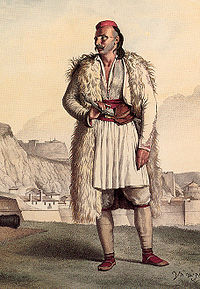
Back فسطاطية (لباس) Arabic Fustanella Azerbaijani Pustanela BCL Фустанела Bulgarian Fustanella BS Fustanela Catalan Fustanella German Φουστανέλα Greek Fustanela Spanish Fustanella Estonian

Fustanella (for spelling in various languages, see chart below) is a traditional pleated skirt-like garment that is also referred to as a kilt worn by men in the Balkans.
The Albanian traditional costume with fustanella had identified the special troops that Albanians constituted within the Ottoman Empire, whose military prowess became renowned, especially in the era of the Ottoman Albanian pashas Ali of Yanina and Muhammad Ali of Egypt.[1] During the late 18th and early 19th centuries Albanian warriors wore it in the Kingdom of Naples and the Ionian Islands.[2] In the 1810s, the Albanian warrior dress was officially adopted by a British regiment in the Ionian Islands.[3] In the 1820s, it became a principal visual symbol of Philhellenism, and during the Greek War of Independence it was worn by the revolutionary fighters.[4] At that time its notoriety as a symbol of male bravery and heroism grew considerably across the Ottoman Empire and spread throughout Europe.[5] Following the Greek independence, fustanella and accompanying embroidered waistcoats and jackets were adopted by the nascent Greek army. In 1835, it was proclaimed the official court costume and eventually it became the Greek national dress.[6] The Albanian-Greek attire thereafter acquired popularity among peoples who wanted to dress in a courageous heroic manner.[5]
In modern times, the fustanella is part of Balkan folk dresses. In Greece, a short version of the fustanella is worn by ceremonial military units such as the Evzones since 1868. In Albania it was worn by the Royal Guard in the interbellum era. Both Greece and Albania claim the fustanella as a national costume.[7]
- ^ Volait 2021, p. 202; Flaherty 2023, pp. 38–39; Scarce 2017, pp. 159–164, 170–172.
- ^ Romagnoli 2010, p. 68; Brnardic 2004, pp. 37–38
- ^ Chartrand & Courcelle 2000, p. 20.
- ^ Volait 2021, p. 202; Baleva 2021, pp. 77–85; Baleva 2017, pp. 241–243; Scarce 2017, pp. 170–172.
- ^ a b Baleva 2021, pp. 77–85; Baleva 2017, pp. 241–243.
- ^ Volait 2021, p. 202; Scarce 2017, pp. 158, 170–172.
- ^ Koço 2004, p. 161